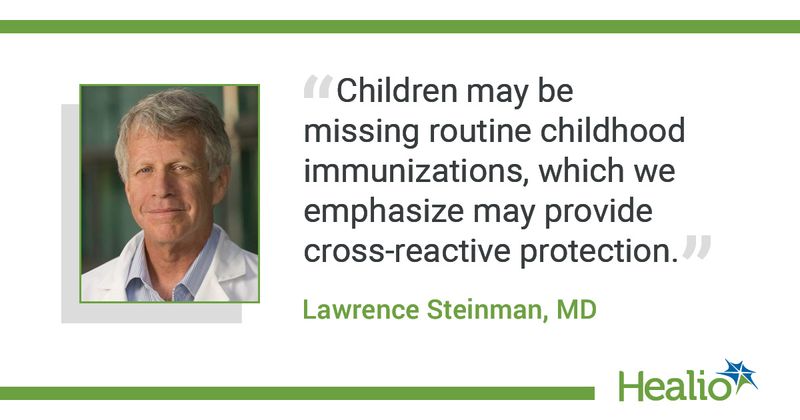Q&A: Why are children less likely to develop COVID-19?
A perspective published in Proceedings of the National Academy of Sciences of the United States of America analyzed the reasons why children are less likely to develop COVID-19 than adults.
The paper lists five possible reasons: the SARS-CoV-2 receptor, angiotensin-converting enzyme 2 (ACE2), is reduced in the respiratory tract of children; coronaviruses associated with common colds may offer some protection; T helper 2 immune responses are protective in children; eosinophilia, which is associated with T helper 2, may be protective; and children generally produce lower levels of inflammatory cytokines.

Healio spoke with Lawrence Steinman, MD, professor of neurology, neurological sciences, pediatrics and genetics at Stanford University, about these possibilities and what they might mean for youth going forward.
Question: Why is ACE2 expression lower in the respiratory tract of children, and is there evidence of an age-related escalation in COVID-19 severity as children get older?
Answer: There is evidence of an age-related escalation; however the granularity is problematic. The vast preponderance of cases is in children aged 5 to 17 years, rather than in children aged 0 to 4 years. The AAP writes about the problems with granularity in children's data by age:
- Format, content and metrics of reported COVID-19 data differed substantially by state.
- Age ranges reported for children varied by state (0-14, 0-17, 0-18, 0-19 and 0-20 years).
- New York did not provide age distribution for statewide cases (New York City only).
- Texas reported age distribution for only 8% of all cases and is excluded from some figures.
- As of Aug. 13, Alabama changed the definition of child case from 0 to 24 to 0 to 17 years.
- As of Aug. 27, Hawaii changed definition of child case from 0 to 19 to 0 to 17 years.
On the subject of why the prevalence of ACE2 is lower in young children, the answer is I can only speculate.
Q: Is there any evidence that prior coronavirus infections offer cross-protection against SARS-CoV-2?
A: Yes, there is evidence that we discuss in the paper — a study in adult donors, aged currently older than 20 years, tested whether there was detectable immunity to SARS-CoV-2 and to common cold viruses attributed to coronavirus strains HCoV-OC43, HCoV-HKU1, HCoV-NL63 and HCoV-229E. Donors were recruited between 2015 and 2018, obviating exposure to SARS- CoV-2. Unexposed donors had T-cell immunity to both spike and nonspike proteins in SARS-CoV-2. The immunity may have emanated from shared regions on the common cold virus and SARS-CoV-2. Investigators tested immunity to one beta-coronavirus HCoV-OC43 and to one alpha-coronavirus NL63 and showed that these unexposed donors (n = 11) all had immune globulin G to the receptor-binding domain of these common cold viruses. These nonexposed donors also had vigorous T-cell responses to both spike and nonspike proteins in SARS-CoV-2. Additional studies have been reported demonstrating widespread immunity in healthy individuals to cross-reactive regions of SARS-CoV-2 that share peptide sequence homology with endemic coronaviruses that cause common colds like HCoV-OC43, HCoV-229E, HCoV- NL63 and HCoV-HKU1. Humoral, antibody immunity to SARS-CoV-2 is widely detected in individuals, including children, who were not exposed to SARS-CoV-2. Immunity to earlier exposures to both alpha and beta coronaviruses may thus engender protective humoral and cellular immunity for children who are heavily exposed to these common cold viruses.
Q: How are T helper 2 immune responses and eosinophilia protective against SARS-CoV-2?
A: The T helper 2 immunity may be particularly toxic to the SARS-CoV-2 virus and its capsule. Eosinophils are a storehouse of proteases. Eosinophils and basophils are effective in combating ticks from feeding.
Q: How do lower levels of inflammatory cytokines influence children’s response to SARS-CoV-2?
A: Lower levels of cytokines make "friendly fire" from the immune system less deadly. The cytokines mediate "friendly fire," otherwise known in COVID-19 as "cytokine storm."
Q: How might the economy be having an impact?
A: With children hunkered down, they are not infecting each other in the sandbox and at school. Some of this immunity is protective — for example, the common coronavirus. Children may be missing routine childhood immunizations, which we emphasize may provide cross-reactive protection. Too much hygiene would also change the "sculpting" of the child's immune system. Encounters with viruses and vaccines are important for immune health. Ultra clean environments are abnormal and impair the development of our immune repertoire.
References:
- AAP. Children and COVID-19: State-level data report. https://services.aap.org/en/pages/2019-novel-coronavirus-covid-19-infections/children-and-covid-19-state-level-data-report/. Accessed Sept. 4, 2020.

